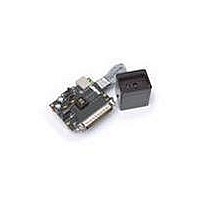HDJD-JD02 Avago Technologies US Inc., HDJD-JD02 Datasheet - Page 17

HDJD-JD02
Manufacturer Part Number
HDJD-JD02
Description
KIT DEV RGB COLOR SENSOR 16-QFN
Manufacturer
Avago Technologies US Inc.
Datasheet
1.HDJD-JD02.pdf
(29 pages)
Specifications of HDJD-JD02
Sensor Type
Light, Color Sensor
Sensing Range
RGB
Interface
Analog
Voltage - Supply
4.5 V ~ 5.5 V
Embedded
No
Utilized Ic / Part
HDJD-S722-QR999
For Use With/related Products
HDJD-S722-QR999
Lead Free Status / RoHS Status
Not applicable / Not applicable
Lead Free Status / RoHS Status
Lead free / RoHS Compliant, Not applicable / Not applicable
17
Color Sensing
Combination of various RGB portions into a mixed color may produce mismatches with the
actual sample color. These circumstances can be corrected with the aid of complex
mathematical algorithms.
Color Differentiation
CIELAB color space is one of the most popular color space for measuring object color and is
widely used in virtually all fields. It is one of the uniform color spaces defined by CIE to reduce
the problem of non-linearity in the original xyY color space (the equal distances on the x,y
chromaticity diagram did not correspond to equal perceived color differences).
In this color space, L* indicates lightness and a* and b* are the chromaticity coordinate. Figure
7.3 shows the a*,b* chromaticity information diagram.
In this diagram,
There are delta values associated with this color scale. L*, a*, and b* indicate how much a standard and
sample differ from one another in L*, a*, and b*. These delta values are often used for quality control or
formula adjustment. Tolerances may be set for the delta values. Delta values that are out of the
tolerances indicate that there is too much difference between the standard and the sample. The type of
correction needed may be determined by which delta value is out of tolerance. For example, if a* is out of
tolerance, the redness/greenness needs to be adjusted. Whether the sample is redder or greener than the
sign of the delta value indicates the standard.
For example, if a* is positive, the sample is redder than the standard. The total color difference, E*, may
also be calculated. The E* is a single value which takes into account the differences between the L*, a*,
and b* of the sample and standard. It does not indicate which parameter(s) (L*, a*, and/or b*) are out of
tolerances if E* is out of tolerance.
The CIELAB color scale may be used on any object whose color may be measured. It is used extensively
in many industries. As was intended, it provides a standard scale for comparison of color values.
•+a* is the red direction,
-a* is the green direction
•+b* is the yellow direction,
-b* is the blue direction
Figure 7.3






















